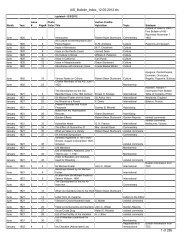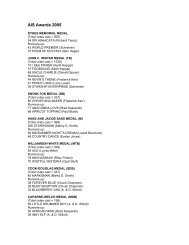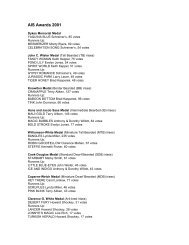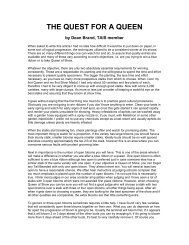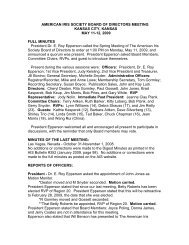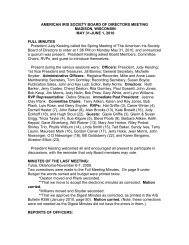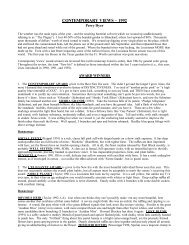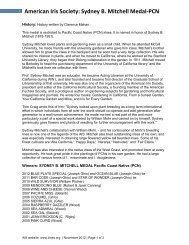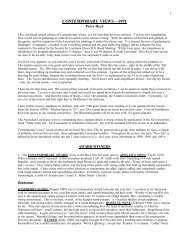contemporary views – 1988 award winners - American Iris Society
contemporary views – 1988 award winners - American Iris Society
contemporary views – 1988 award winners - American Iris Society
You also want an ePaper? Increase the reach of your titles
YUMPU automatically turns print PDFs into web optimized ePapers that Google loves.
white, heavily banded a sensuous oxblood red. Outstanding wide form, and lightly ruffled. Another exciting plicata is<br />
FIDDLE FADDLE (Hager 1989), similar in color and pattern to its dwarf parent, ‘Pepper Mill’ (Hager): A light yellow<br />
ground plic, heavily peppered and strippled in chocolate. An overlooked plicata is BLUE CALICO (C. Palmer 1986), a<br />
pure blue on white plic with excellent form and proportion. The banding is the bluest of the blue IB plics I’ve seen<br />
thusfar. NECTAR (Keppel 1990) is from plicata breeding also, but appears as a nectarine-yellow blend with no markings<br />
to the eye. Classy form. Bright orange beards tipped red. Two Aussies complete the category this year. They’re sibs,<br />
but totally different from each other, and a lot of fun: POSH (Blyth 1987) is an insanely vigorous apricot-salmon blend<br />
with gorgeous deep orange beards. STRUM (Blyth 1987) is a yellow amoena, but with the same screaming beards. Both<br />
are sufficiently wide, with simplistic form and finish to allow the eye to concentrate on the color combos.<br />
CLASSICS: RUBY CHIMES (A. Brown 1972); SPACE CADET (Moldovan 1970); SWEETIE (Warburton 1971).<br />
STANDARD DWARF BEARDEDS:<br />
The early success of SERENITY PRAYER (me, 1989) has been most gratifying. I’m getting great reports from all over<br />
the country, and we’re now hearing that it’s a reliable repeat bloomer and rebloomer. One of Paul Black’s releases from<br />
the same year is similar in background but distinctive enough from ‘Serenity Prayer’ that they really shouldn’t be<br />
compared: SIGH (1989) is a magnificent work of art, with cool icy white flowers blessed with elegant soft blue beards.<br />
Needless to say, we’re trying to mate the two! ‘Sigh’ has excellent form and substance supreme, with no other coloration<br />
to distract from the glacial effect.<br />
A cute new ‘Chubby Cheeks’ kid released this year, INKY DINKY (Black 1991), is like a mini-version of the TB,<br />
‘Circus Stripes’ (Plough), but with tight, compact dwarf form and more consistent plicata striations. A double shot of<br />
‘Chubby Cheeks’ produced MUPPET MADNESS (Black 1991). The standards are almost completely infiltrated with a<br />
rich, bold purple from the red side. The falls have a little bit of white peeking through, but are banded in a solid redpurple,<br />
then the color eeks out onto the center of the falls, seeking the deep purple beards. This is the same cross that<br />
produced true luminatas which you’ll be seeing soon. Like, right now: TROUBADOUR’S SONG (Black 1991) is<br />
surely the strangest of the lot, and I love it. The standards are a white base, but almost completely infused in orchidlavender<br />
and tan, and a tan halo. The falls are basically the same pattern, but with slightly deeper colors and more of a<br />
white halo. Follow the halo up to the shoulders and beard area, and there you have it --- loooominata! Make it in the<br />
shape of ‘Chubby Cheeks’ and you have a wonderful addition to the rare luminatas. A couple of lemon yellows from Cleo<br />
Palmer were most impressive this year: SENSATIONAL (1990) is a broad, shapely blending of lemon yellow, with the<br />
color gradually lightening to near white in the midribs of the standards and in the upper part of the falls around the beards.<br />
Superb substance and light ruffling. SPANISH EMPIRE (1990) is a sib, very similar in color and pattern, but has even a<br />
touch of lace. Both are very strong growers.<br />
PUMPIN’ IRON (Black 1990) is a butch, bold color study in rich dark tones, with vibrant red-black standards over falls<br />
which hold an even deeper black cherry spot, surrounded by a glow of rich magenta purple edging. Remindful of a muchimproved,<br />
modern ‘Bloodspot’ (Craig). No steroids here <strong>–</strong> just a good solid, disciplined bloodline. Its papa, FORTE<br />
(Black 1987) continues to impress me, and its smaller flowers should be a valuable tool in SDB breeding. Sharp, perky<br />
colors, with vibrant deep orchid standards and velveteen blackish-red falls, highlighted with pansy purple beards. An<br />
excellent garden subject, with outstanding plant habits it passes on to its children. One of Paul’s that has been overlooked<br />
was one of my AM votes for the year: MARY’S LAMB (1987), smaller and petite in stature, it is a pert white with warm<br />
shoulders of creamy yellow, ruffled, and the gentle pale violet-blue beards in harmony with the mood created. This distant<br />
cousin of ’Serenity Prayer’ has perfect proportions, with a mound of bloom on a vigorous plant, leaving plenty of increase<br />
for next year.<br />
An SDB that sneaked up on me was SPLIT DECISION (Hobbs 1989), an unusual amoena (all too rare in SDBs, and<br />
I’m not sure why) with pure white standards hovering over cool violet-blue falls which are then edged in a fine halo of<br />
white, with cream beards. The color in the falls appears to be stroked onto the white base with an artist’s brush, but the<br />
effect is a solid color nonetheless. Slender delicate stalks have 1 to 2 branches, and 2 to 4 buds. A Hager SDB that has<br />
been overlooked by the judges thusfar is RUSTY DUSTY (<strong>1988</strong>), a well-named, bronzy rust-brown plicata on full yellow<br />
ground, with the falls an even deeper coloring. A notably better performer and increaser than some of the brown plic SDBs<br />
released over the years. Another SDB whose name well describes its appearance is OH JAY (Lankow <strong>1988</strong>), a compact<br />
colorful saffron yellow that blends into light orange (juice), marked with bold orange beards. Very vigorous, but my only<br />
complaint is that the foliage (this year) was very messy, easily leafspotting and “burning” on the edges from excess<br />
moisture. Hopefully it won’t do that again.<br />
And lastly, a nice breeding partner for Barry Blyth’s blue-bearded pinks such as ‘Kandi Moon’ is PINK PANTHER<br />
(Willott <strong>1988</strong>), a funky pale pink, warmed at the hafts with ambers shoulders, and then zipped up with a pale to light blue<br />
48



